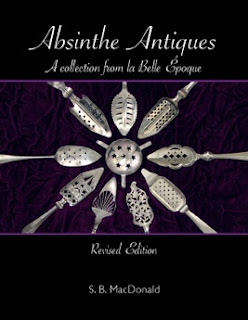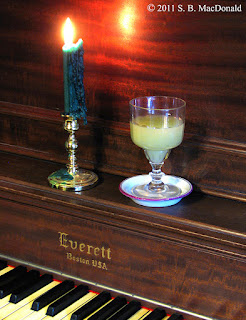Absinthe Antiques
Contributed by on Mar 14, 2013
Two readers love this post.
There is no hidden significance in my use of the above photo in an article called "Absinthe Antiques!" From left to right, it shows me, Kamal Mukherjee of DrinkUp NY, Scott MacDonald (more about him in a second), and Maxwell Britten of Maison Premiere. We're at Maison Premiere here. It's a rare photo showing four absinthe "movers and shakers," none of whom seem to be drinking absinthe. To be fair to us (and our livers), some of us had started drinking absinthe a little earlier (Maison Premiere's Happy Hour offer of $1 oysters is a must) and some of us would be seen drinking absinthe cocktails a few hours later in Battery Park!
This was the first time one of the most important US absinthe retailers (Kamal) had met with one of the most important US absinthe mixologists (Maxwell). It was also the first time I had met with fellow absinthe forum member, Scott, and it is always great to find fellow absinthe lovers several thousand miles from home. Scott makes and designs guitars for a living (what a nice job!) and indulges his love of hand-crafted absinthe and the paraphernalia surrounding absinthe in many of his spare time moments. And now he is becoming well-known in his own right as the author of Absinthe Antiques: A Collection from la Belle Époque.
Scott kindly arranged an advance digital copy of the revised edition of Absinthe Antiques for me a few weeks ago, and I have been enjoying it enormously. If some people can derive a lot pleasure drinking absinthe by feeling that they are enjoying history (and absinthe has more than its fair share of history), then what better way to enjoy that history by drinking absinthe in antique glasses, using antique spoons, antique pourers etc? Sadly, however, while most of my readers can access good absinthe at a variety of prices, it is not possible for all of us to enjoy drinking them using antiques. Which is where Scott's book comes in. In sumptuous details, he shares with us an "orgy" of antiques, from fountains
through spoons
and glasses,
and many, many other types of advertising ephemera that you need to read about and to see to understand.
All with just the right amount of accompanied text to get the reader involved in the subject!
Eagle-eyed readers will have noticed that this is the revised edition. However, it's much more than just "the Director's Cut." At 221 pages with more than 300 photographs, it is more than twice as long as the first edition. This also has new chapters on postcards, art, antique bottles, the Pontarlier Museum's absinthe exhibit and the absinthe antiques market at the Absinthiades (sorry to say, Scott, that with the new Absinthe Museum opening in the Val-de-Travers in 2013, you may need to add a section on that too!).
I asked Scott what was his vision of the book, and his reply was illuminating. "What seems to happen for many reading it is this: they come away with a deeper understanding of what absinthe is and was, despite it being a book about the pieces used in its service. It's almost as if it is a round-about way of seeing absinthe through the eyes of its history. The spirit of the Belle Époque is clear in these antiques, as is the romantic way I feel about them."
And, to me, it's clear that Scott's vision has been achieved here.
To describe Absinthe Antiques as a coffee table book might be accurate, but it doesn't do the book justice. Yes, it's a great book to have at home to dip into from time to time. But it's also one of those rare books in which the passion of the author for his subject is clear on every page. You can see Scott's love for his antiques in the way he has organised his compositions ... the backgrounds, the lighting, the shots themselves and the whole layout of the book.
And at a time when many things are becoming smaller (iPad minis etc), it's nice to find it's a big book too, as this photo makes clear (11" x 8.5," so 17" wide when opened).
Two final comments.
Since it's a book about antiques, it might have been interesting to have told the reader how much the items shown actually cost (or maybe a range of costs). That would have made it an even more useful reference work, although I know it is not always easy to put an accurate value on antiques. And maybe the prices would have scared people! I put this point to Scott, and his eloquent response was that he did not want to talk about something that has nothing to do with the spirit and original purpose of the antiques. He prefers to celebrate the antiques, rather than to demean them with a monetary value. In any case, "For the price of a couple of bottles of absinthe, one can easily find a full service for two of very nice spoons, saucers and glasses!"
A nice detail for the French (and those in the French-speaking part of Switzerland): the book includes a complete French translation (by Marc Thuillier) via an appendix.
And here's my favourite photo, which serves so well to illustrate the care Scott has taken with details: an Everett upright grand piano, born between 1900 and 1905 in Boston, birthplace of the vintage American absinthe Butterfly of the same era (that's NOT a pre-ban Butterfly here!).
Finally, reader, beware. Some of the more unscrupulous online absinthe "dealers" exaggerate the completely irrelevant "drug" side of absinthe. Absinthe Antiques, however, could well prove addictive, and you may find yourself scouring the markets for antiques every weekend ...
Availability details for the book are here.
Santé, Scott, for an excellent, enjoyable (but maybe addictive!) book.



